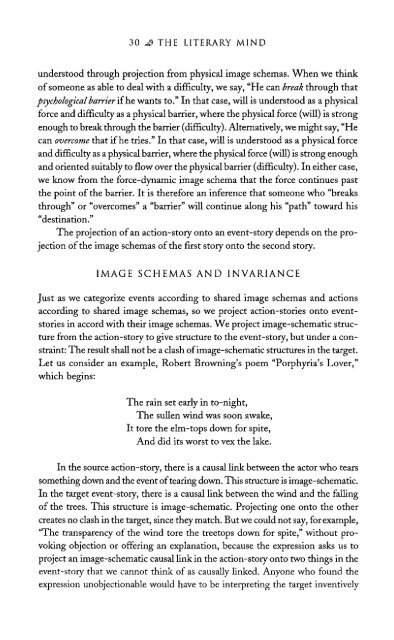The Literary Mind.pdf
The Literary Mind.pdf
The Literary Mind.pdf
You also want an ePaper? Increase the reach of your titles
YUMPU automatically turns print PDFs into web optimized ePapers that Google loves.
30 THE LITERARY MIND<br />
understood through projection from physical image schemas. When we think<br />
of someone as able to deal with a difficulty, we say, "He can break through that<br />
psychological barrier if he wants to." In that case, will is understood as a physical<br />
force and difficulty as a physical barrier, where the physical force (will) is strong<br />
enough to break through the barrier (difficulty). Alternatively, we might say, "He<br />
can overcome that if he tries." In that case, will is understood as a physical force<br />
and difficulty as a physical barrier, where the physical force (will) is strong enough<br />
and oriented suitably to flow over the physical barrier (difficulty). In either case,<br />
we know from the force-dynamic image schema that the force continues past<br />
the point of the barrier. It is therefore an inference that someone who "breaks<br />
through" or "overcomes" a "barrier" will continue along his "path" toward his<br />
"destination."<br />
<strong>The</strong> projection of an action-story onto an event-story depends on the projection<br />
of the image schemas of the first story onto the second story.<br />
IMAGE SCHEMAS AND INVARIANCE<br />
Just as we categorize events according to shared image schemas and actions<br />
according to shared image schemas, so we project action-stories onto eventstories<br />
in accord with their image schemas. We project image-schematic structure<br />
from the action-story to give structure to the event-story, but under a constraint:<br />
<strong>The</strong> result shall not be a clash of image-schematic structures in the target.<br />
Let us consider an example, Robert Browning's poem "Porphyria's Lover,"<br />
which begins:<br />
<strong>The</strong> rain set early in to-night,<br />
<strong>The</strong> sullen wind was soon awake,<br />
It tore the elm-tops down for spite,<br />
And did its worst to vex the lake.<br />
In the source action-story, there is a causal link between the actor who tears<br />
something down and the event of tearing down. This structure is image-schematic.<br />
In the target event-story, there is a causal link between the wind and the falling<br />
of the trees. This structure is image-schematic. Projecting one onto the other<br />
creates no clash in the target, since they match. But we could not say, for example,<br />
"<strong>The</strong> transparency of the wind tore the treetops down for spite," without provoking<br />
objection or offering an explanation, because the expression asks us to<br />
project an image-schematic causal link in the action-story onto two things in the<br />
event-story that we cannot think of as causally linked. Anyone who found the<br />
expression unobjectionable would have to be interpreting the target inventively















